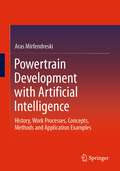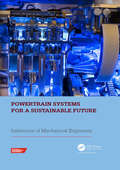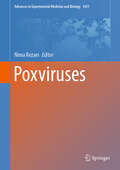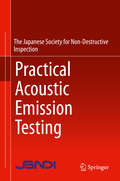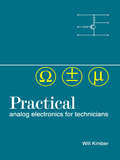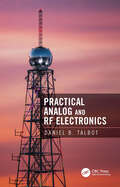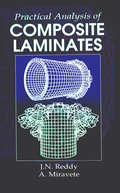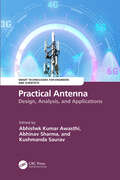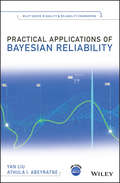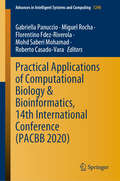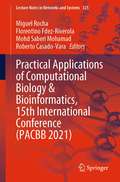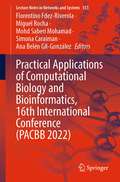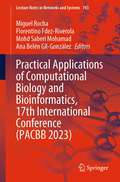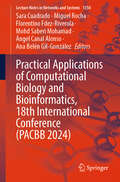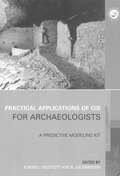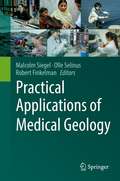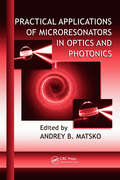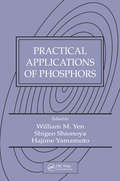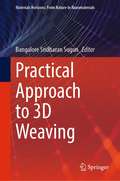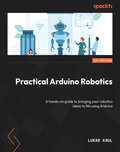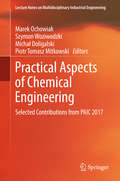- Table View
- List View
Powertrain Development with Artificial Intelligence: History, Work Processes, Concepts, Methods and Application Examples
by Aras MirfendreskiThe variety of future powertrain concepts has drastically increased the development cost for automotive manufactures. Profitable investment requires a significantly leaner and efficient powertrain development process. Traditional methods of test and model based development need to be assisted by big data and data analytics. For this purpose, a valuable tool is available at the right time - artificial intelligence (AI). But what does AI really mean in a narrower sense? What concepts lie behind it? And how are the methods and algorithms transferable to powertrain applications? For the first time, this book aims to bridge the gap between automotive engineering and computer science, by illuminating the complexity of current AI concepts and demystifying it for powertrain applications. By elaborating on work processes, it shows how AI could be implemented and how completely novel methods can help us reshape the future of mobility.
Powertrain Instrumentation and Test Systems
by Michael Paulweber Klaus LebertThe bookdeals with the increasingly complex test systems for powertrain components andsystems giving an overview of the diverse types of test beds for allcomponents of an advanced powertrain focusing on specific topics such asinstrumentation, control, simulation, hardware-in-the-loop, automation or testfacility management. This book is intended for powertrain (component)development engineers, test bed planners, test bed operators and beginners.
Powertrain Systems for Net-Zero Transport
by Institution of Mechanical EngineersThe transport sector continues to shift towards alternative powertrains, particularly with the UK Government’s announcement to end the sale of petrol and diesel passenger cars by 2030 and increasing support for alternatives. Despite this announcement, the internal combustion continues to play a significant role both in the passenger car market through the use of hybrids and sustainable low carbon fuels, as well as a key role in other sectors such as heavy-duty vehicles and off-highway applications across the globe. Building on the industry-leading IC Engines conference, the 2021 Powertrain Systems for Net-Zero Transport conference (7-8 December 2021, London, UK) focussed on the internal combustion engine’s role in Net-Zero transport as well as covered developments in the wide range of propulsion systems available (electric, fuel cell, sustainable fuels etc) and their associated powertrains. To achieve the net-zero transport across the globe, the life-cycle analysis of future powertrain and energy was also discussed. Powertrain Systems for Net-Zero Transport provided a forum for engine, fuels, e-machine, fuel cell and powertrain experts to look closely at developments in powertrain technology required, to meet the demands of the net-zero future and global competition in all sectors of the road transportation, off-highway and stationary power industries.
Powertrain Systems for a Sustainable Future: Proceedings of the International Conference on Powertrain Systems for a Sustainable Future 2023, London, UK, 29- 30 November 2023
by Institution of Mechanical EngineersThe transport sector continues to shift towards alternative powertrains, particularly with the UK Government’s focus on ending the sale of petrol and diesel passenger cars by 2030 and increasing support for alternatives. Despite this announcement, the internal combustion could continue to play a significant role both in the passenger car market through the use of hybrids and sustainable low carbon fuels including hydrogen, as well as a key role in other sectors such as heavy-duty vehicles and off-highway applications across the globe. The contributions presented at the International Conference on Powertrain Systems for a Sustainable Future 2023 (London, UK, 29- 30 November 2023) focus on the internal combustion engine’s role in net-zero transport as well as covering developments in the wide range of propulsion systems available (electric, hydrogen internal combustion engines and fuel cells, sustainable fuels etc) and their associated powertrains. To achieve a sustainable future for transport across the globe we will need to deploy all technologies and so, to help understand how these might fit together, life-cycle analysis of future powertrain systems and energy will also be included. Powertrain Systems for a Sustainable Future provides a forum for engine, fuels, e-machine, fuel cell and powertrain experts to look closely at developments in powertrain technology required to meet the demands of the net-zero future and global competition in all sectors of the road transportation, off-highway, marine and stationary power industries.
Poxviruses (Advances in Experimental Medicine and Biology #1451)
by Nima RezaeiSince the emergence of 2022’s monkeypox virus (MPXV) outbreak, it has been the heading of news and research articles that MPXV is being involving non-endemic areas after about its 80-year presence in endemic areas. Efforts are concentrated on understanding how MPXV has evolved to cause an epidemic. The book provides a comprehensive compendium of chapters on poxviruses in different domains. It concludes that the main problem we should deal with is not to address how MPXV has overcome the distance between non-endemic and endemic areas, but it is the non-cooperativity of logistics, research, and science in managing poxviruses’ outbreaks.
Practicable Learning Analytics (Advances in Analytics for Learning and Teaching)
by Olga Viberg Åke GrönlundThis book is about practicable learning analytics, that is able to become a successful part of practice, ultimately leading to improved learning and teaching. The aim of the book is to shift our perspective on learning analytics creation and implementation from that of “designing of” technology to that of “designing for” a system of practice. That is, any successful implementation of learning analytics requires a systematic approach, which the book explains through the lens of the Information Systems Artefact, constituting of the three interdependent artefacts: “technical”, “information” and “social”.The contributions of this book go beyond a consideration of particular humans such as teachers and students, and their individual activities to consider the larger systems of activity of which analytics become part of. The chapters included in this book present different cases of learning analytics implementation across countries, and the related opportunities and challenges related to generalizability of the results.The book is written for designers, students and educators of learning analytics who aim to improve learning and teaching through learning analytics.
Practical Acoustic Emission Testing
by The Japanese Society for Non-Destructive InspectionThis book is intended fornon-destructive testing (NDT) technicians who want to learn practical acousticemission testing based on level 1 of ISO 9712 (Non-destructive testing -Qualification and certification of personnel) criteria. The essential aspectsof ISO/DIS 18436-6 (Condition monitoring and diagnostics of machines -Requirements for training and certification of personnel, Part 6: AcousticEmission) are explained, and readers can deepen their understanding with thehelp of practice exercises. This work presents the guiding principles ofacoustic emission measurement, signal processing, algorithms for sourcelocation, measurement devices, applicability of testing methods, andmeasurement cases to support not only researchers in this field but also and especiallyNDT technicians.
Practical Analog Electronics for Technicians
by W A Kimber'Practical Analog Electronics for Technicians' not only provides an accessible introduction to electronics, but also supplies all the problems and practical activities needed to gain hands-on knowledge and experience. This emphasis on practice is surprisingly unusual in electronics texts, and has already gained Will Kimber popularity through the companion volume, 'Practical Digital Electronics for Technicians'. Written to cover the Advanced GNVQ optional unit in electronics, this book is also ideal for BTEC National, A-level electronics and City & Guilds courses. Together with 'Practical Digital Electronics for Technicians', this text comprises a complete practical electronics course designed for students with little prior knowledge of the subject.
Practical Analog and RF Electronics
by Daniel B. TalbotThis is a book about real-world design techniques for analog circuits: amplifiers, filters, injection-locked oscillators, phase-locked loops, transimpedance amplifiers, group delay correction circuits, notch filters, and spectrum regrowth in digital radio frequency (RF) transmitters, etc. The book offers practical solutions to analog and RF problems, helping the reader to achieve high-performance circuit and system design. A variety of issues are covered, such as: How to flatten group delay of filters How to use reciprocity to advantage How to neutralize a parasitic capacitance How to deepen a notch by adding only two components to the network How to demodulate a signal using the secant waveform and its benefit How to flatten the frequency response of a diode detector When to use a transimpedance amplifier and how to maximize its performance How to recover non-return-to-zero (NRZ) data when alternating current (AC) coupling is required Why phase noise corrupts adjacent communication channels Simple method to prevent false locking in phase-locked loops How to improve the bandwidth of amplification by using current conveyors A very simple impedance matching technique requiring only one reactive component How to use optimization Quadrature distortion and cross-rail interference This book is meant to be a handbook (or a supplemental textbook) for students and practitioners in the design of analog and RF circuitry with primary emphasis on practical albeit sometimes unorthodox circuit realizations. Equations and behavioral simulations result in an abundance of illustrations, following a "words and pictures" easy-to-understand approach. Teachers will find the book an important supplement to a standard analog and RF course, or it may stand alone as a textbook. Working engineers may find it useful as a handbook by bookmarking some of the step-by-step procedures, e.g., the section on simplified impedance matching or group delay flattening.
Practical Analysis of Composite Laminates (Applied and Computational Mechanics #1)
by Antonio Miravete J. N. ReddyComposite materials are increasingly used in aerospace, underwater, and automotive structures. They provide unique advantages over their metallic counterparts, but also create complex challenges to analysts and designers. Practical Analysis of Composite Laminates presents a summary of the equations governing composite laminates and provides practical methods for analyzing most common types of composite structural elements. Experimental results for several types of structures are included, and theoretical and experimental correlations are discussed. The last chapter is devoted to practical analysis using Designing Advanced Composites (DAC), a PC-based software on the subject. This comprehensive text can be used for a graduate course in mechanical engineering, and as a valuable reference for professionals in the field.
Practical Antenna: Design, Analysis, and Applications (Smart Technologies for Engineers and Scientists)
by Abhinav Sharma Abhishek Kumar Awasthi Kushmanda SauravAntennas are an important component of every communication systems, including radio, television, satellite, radar, and cellular networks which transmits and receive radio waves over the wireless channel. The field of antenna is quite vast, and with the current development in the wireless technologies enormous amount of work and effort has been put in the design, analysis, and applications of antennas. As an individual, a reader has to put a lot of effort to understand the modern antenna analysis and design for various applications. Therefore, the editors and authors of this book have come-up with an idea of putting all the necessary information required at one centralized place in the form of a book. The readers of this book will be able to access all the necessary information of antennas, from basic to advanced, theory to practical and its modern applications. The text provides information on antenna design for next generation communication systems and IoT applications, followed by the integration of the antennas in the wireless system, and also covers multi-input and multi-output (MIMO) antennas, metasurface antennas, reconfigurable antennas, fractal antennas and design of beamforming networks.This book: Focuses on modern antennas for 5G communication systems and next-generation Internet of Things (IoT) networks Highlights fractal radiator-based printed linear antenna arrays designed for direct broadcast satellite applications with a particular focus on direct-to home (DTH) services Covers the implementation of modern swarm intelligence optimization techniques for antenna array pattern synthesis Includes general framework for the design and optimization of metasurface antennas Presents design and development of high-gain millimeter-wave beam switching antennas using passive frequency selective surfaces (FSS) This book can also serve as a valuable reference for undergraduate, post-graduate students, as well as researchers working in radio frequency (RF) and microwave.
Practical Applications of Bayesian Reliability (Quality and Reliability Engineering Series)
by Yan Liu Athula I. AbeyratneDemonstrates how to solve reliability problems using practical applications of Bayesian models This self-contained reference provides fundamental knowledge of Bayesian reliability and utilizes numerous examples to show how Bayesian models can solve real life reliability problems. It teaches engineers and scientists exactly what Bayesian analysis is, what its benefits are, and how they can apply the methods to solve their own problems. To help readers get started quickly, the book presents many Bayesian models that use JAGS and which require fewer than 10 lines of command. It also offers a number of short R scripts consisting of simple functions to help them become familiar with R coding. Practical Applications of Bayesian Reliability starts by introducing basic concepts of reliability engineering, including random variables, discrete and continuous probability distributions, hazard function, and censored data. Basic concepts of Bayesian statistics, models, reasons, and theory are presented in the following chapter. Coverage of Bayesian computation, Metropolis-Hastings algorithm, and Gibbs Sampling comes next. The book then goes on to teach the concepts of design capability and design for reliability; introduce Bayesian models for estimating system reliability; discuss Bayesian Hierarchical Models and their applications; present linear and logistic regression models in Bayesian Perspective; and more. Provides a step-by-step approach for developing advanced reliability models to solve complex problems, and does not require in-depth understanding of statistical methodology Educates managers on the potential of Bayesian reliability models and associated impact Introduces commonly used predictive reliability models and advanced Bayesian models based on real life applications Includes practical guidelines to construct Bayesian reliability models along with computer codes for all of the case studies JAGS and R codes are provided on an accompanying website to enable practitioners to easily copy them and tailor them to their own applications Practical Applications of Bayesian Reliability is a helpful book for industry practitioners such as reliability engineers, mechanical engineers, electrical engineers, product engineers, system engineers, and materials scientists whose work includes predicting design or product performance.
Practical Applications of Computational Biology & Bioinformatics, 14th International Conference (Advances in Intelligent Systems and Computing #1240)
by Florentino Fdez-Riverola Mohd Saberi Mohamad Miguel Rocha Gabriella Panuccio Roberto Casado-VaraThis book highlights the latest research on practical applications of computational biology and bioinformatics, and addresses emerging experimental and sequencing techniques that are posing new challenges for bioinformatics and computational biology. Successfully applying these techniques calls for new algorithms and approaches from fields such as statistics, data mining, machine learning, optimization, computer science, and artificial intelligence. In response to these challenges, we have seen the rise of a new generation of interdisciplinary scientists with a strong background in the biological and computational sciences.These proceedings include 21 papers covering many different subfields of bioinformatics and computational biology. Focusing on interdisciplinary applications that combine e.g. bioinformatics, chemoinformatics, and system biology, they are intended to promote the collaboration of scientists from different research groups and with different backgrounds (computer scientists, mathematicians, biologists) to reach breakthrough solutions and overcome the challenges outlined above.
Practical Applications of Computational Biology & Bioinformatics, 15th International Conference (Lecture Notes in Networks and Systems #325)
by Florentino Fdez-Riverola Mohd Saberi Mohamad Miguel Rocha Roberto Casado-VaraThis book features novel research papers spanning many different subfields in bioinformatics and computational biology, presenting the latest research on the practical applications to promote fruitful interactions between young researchers in different areas related to the field. Clearly, biology is increasingly becoming a science of information, requiring tools from the computational sciences. To address these challenges, we have seen the emergence of a new generation of interdisciplinary scientists with a strong background in the biological and computational sciences. PACBB'21 expects to contribute to this effort by encouraging a successful collaboration of researchers in different areas related to bioinformatics. The PACBB'21 technical program included 17 papers covering many different subfields in bioinformatics and computational biology. Therefore, this conference, held in Salamanca (Spain), definitely promotes the collaboration of scientists from different research groups and with different backgrounds (computer scientists, mathematicians, biologists) to reach breakthrough solutions for these challenges.
Practical Applications of Computational Biology and Bioinformatics, 16th International Conference (Lecture Notes in Networks and Systems #553)
by Florentino Fdez-Riverola Mohd Saberi Mohamad Miguel Rocha Simona Caraiman Ana Belén Gil-GonzálezThis book is suitable for researchers and practitioners in biology, medicine and health sciences and bioinformatics. The success of bioinformatics and computational biology in recent years has been driven by research through computational tools and techniques that are essential for data analysis in modern biology and medicine.Systems biology is a related research area that has been replacing the reductionist view that dominated biology research in the last decades, requiring the coordinated efforts of biological researchers with those related to data analysis, mathematical modelling, computer simulation and optimization. The accumulation and exploitation of large-scale databases prompt new computational technology and for research into these issues. In this context, many widely successful computational models and tools used by biologists in these initiatives, such as clustering and classification methods for gene expression data, are based on computer science/ artificial intelligence (CS/AI) techniques. In fact, these methods have been helping in tasks related to knowledge discovery, modelling and optimization tasks, aiming at the development of computational models so that the response of biological complex systems to any perturbation can be predicted.This proceedings of the 16th International Conference on Practical Applications of Computational Biology and Bioinformatics (PACBB), held in L’Aquila (Italy) from July 13 to 15, 2022, contains ten original contributions of authors from many different countries (Bahrain, Canada, France, Italy, Portugal, Saudi Arabia, Spain, and UK) and different subfields in bioinformatics and computational biology.It is also suitable for artificial intelligence researchers interested in exploring applications in biology and health sciences and computational models.
Practical Applications of Computational Biology and Bioinformatics, 17th International Conference (Lecture Notes in Networks and Systems #743)
by Florentino Fdez-Riverola Mohd Saberi Mohamad Miguel Rocha Ana Belén Gil-GonzálezThis book aims to promote the interaction among the scientific community to discuss applications of CS/AI with an interdisciplinary character, exploring the interactions between sub-areas of CS/AI, bioinformatics, chemoinformatics, and systems biology. The success of bioinformatics in recent years has been prompted by research in molecular biology and molecular medicine in several initiatives. This year’s technical program presents both high quality and diversity, with contributions in well-established and evolving areas of research. The PACBB’23 technical program has selected 9 full papers in the main track and, as in past editions, it will be special issues in ranked journals. This symposium is organized by the LASI and Centro Algoritmi of the University of Minho (Portugal). The authors would like to thank all the contributing authors, the members of the program committee, national associations (AEPIA, APPIA), and the sponsors (AIR Institute).
Practical Applications of Computational Biology and Bioinformatics, 18th International Conference (Lecture Notes in Networks and Systems #1350)
by Florentino Fdez-Riverola Mohd Saberi Mohamad Miguel Rocha Sara Cuadrado Ana Belén Gil-González Ángel Canal AlonsoThis book aims to promote the interaction among the scientific community to discuss applications of CS/AI with an interdisciplinary character, exploring the interactions between sub-areas of CS/AI, Bioinformatics, Chemoinformatics and Systems Biology. The success of Bioinformatics in recent years has been prompted by research in Molecular Biology and Molecular Medicine in several initiatives. This year’s technical program presents both high quality and diversity, with contributions in well-established and evolving areas of research. The PACBB’24 technical program has selected 22 full papers in the main track and, as in past editions, it will be special issues in ranked journals. This symposium is organized by the BISITE Research Group of the University of Salamanca (Spain). The author would like to thank all the contributing authors, the members of the Program Committee, National Associations (AEPIA, APPIA), and the sponsors (AIR Institute).
Practical Applications of GIS for Archaeologists: A Predictive Modelling Toolkit
by Konnie L. Wescott R. Joe BrandonGIS is the most powerful technology introduced to archaeology since the introduction of carbon 14 dating. The most widespread use of this technology has been for the prediction of archaeological site locations. Practical Applications of GIS for Archeologists: A Predictive Modeling Kit focuses on the use of GIS for archaeological predictive modeling. The contributors include internationally recognized researchers who have been at the forefront of this revolutionary integration of GIS and archaeology, as well as first generation researchers who have begun to critically apply this new technology and explore its theoretical implications. A CD-ROM of color illustrations is provided.
Practical Applications of Medical Geology
by Olle Selinus Robert Finkelman Malcolm SiegelThis edited volume provides a framework for integrating methods and information drawn from geological and medical sciences and provides case studies in medical geology to illustrate the usefulness of this framework for crafting environmental and public health policies related to natural materials. The relevance of medical geology research to policy decisions is a topic rarely discussed, and this volume attempts to be a unique source for researchers and policy makers in the field of medical geology in addressing this gap in practical medical geology applications. The book's four sections establish this framework in detail using risk assessment, case studies, data analyses and specific medical geology techniques. Following an introduction to medical geology in the context of risk assessment and risk management, the second section discusses specific methods used in medical geology in the categories of geoscience, biomedicine, and data sources. The third section discusses the medical geology of natural materials, energy use, and environmental and workplace impacts. This section includes specific case studies in medical geology, and describes how the methods and data from the previous section are used in a medical geology analysis. The fourth section includes a guide to the medical geology literature and provides some examples of medical geology programs in Asia and Africa.
Practical Applications of Microresonators in Optics and Photonics (Optical Science and Engineering)
by Andrey B. MatskoAssembling an international team of experts, this book reports on the progress in the rapidly growing field of monolithic micro- and nanoresonators. The book opens with a chapter on photonic crystal-based resonators (nanocavities). It goes on to describe resonators in which the closed trajectories of light are supported by any variety of total internal reflection in curved and polygonal transparent dielectric structures. The book also covers distributed feedback microresonators for slow light, controllable dispersion, and enhanced nonlinearity. A portion of coverage is dedicated to the unique properties of resonators, which are extremely efficient tools when conducting multiple applications.
Practical Applications of Phosphors
by William M. Yen Shigeo Shionoya Hajime YamamotoDrawn from the second edition of the best-selling Phosphor Handbook, Practical Applications of Phosphors outlines methods for the production of various phosphors and discusses a broad spectrum of applications. Beginning with methods for synthesis and related technologies, the book sets the stage by classifying and then explaining practical phosphors according to usage. It describes the operating principle and structure of phosphor devices and the phosphor characteristics required for a given device, then covers the manufacturing processes and characteristics of phosphors. The book discusses research and development currently under way on phosphors with potential for practical usage and touches briefly on phosphors that have played a historical role, but are no longer of practical use. It provides a comprehensive treatment of applications including lamps and cathode-ray tubes, x-ray and ionizing radiation, and for vacuum fluorescent and field emission displays and covers inorganic and organic electroluminescence materials. The book also covers phosphors for plasma displays, organic fluorescent pigments, and phosphors used in a variety of other practical applications. Emphasizing the practical and cutting-edge nature of the material included, the editors round out their coverage with a discussion of solid-state and organic laser materials.
Practical Approach to 3D Weaving (Materials Horizons: From Nature to Nanomaterials)
by Bangalore Sridharan SugunThree Dimensional Weaving is a nascent technology which has triggered research interests around the world. The technology has the potential to finely balance the in-plane and out-of plane properties in composites. This state-of-the-art book focuses on three emerging 3D weaving technologies viz., Orthogonal weaving, Angle interlock weaving and Dual Plane shedding based 3D weaving. It provides focused knowledge about these technologies and has a pragmatic approach to developing customized 3D weaving machines. Fundamental approach to understanding weave design basics, thereupon practical weaving , addressing quality aspects, arriving at testing approaches are all detailed in the book. The applications for these technologies are both in strategic (space, aerospace, defense) as well as societal (medical, automobile) sectors.The book has six chapters, wherein the first three chapters are devoted to Orthogonal and angle interlock weaving and their quality control aspects. Approach to weaving preforms of complex geometries such as T-stiffeners, tapers, Origami-based structures are also discussed The fourth and fifth chapter are entirely devoted to machinery development for Dual plane shedding based 3D weaving often termed as ‘True 3D weaving’. The chapters discuss detailed machine design of the sub-elements such as let-off, shedding, picking, beat-up and take-up. The reader is taken through a prototype development of a 3D weaving machine by way of concept, illustrations, practical development and weaving of samples. The sixth chapter summarises the editor’s views about the technology. This volume will be beneficial to scientists and researchers in both academia and the industry.
Practical Arduino Robotics: A hands-on guide to bringing your robotics ideas to life using Arduino
by Lukas KaulBuild your hardware, electronics, and programming skills, and use them to realize your advanced robotics projects with this powerful platformPurchase of the print or Kindle book includes a free PDF eBookKey FeaturesBecome an expert in selecting sensors, motors, and Arduino boards for any robotics projectDiscover how to write effective and reusable code for your Arduino robotics projectsLearn to build a camera-based line follower and a self-balancing telepresence robot on your ownBook DescriptionEvery robot needs a “brain,” and the Arduino platform provides an incredibly accessible way to bring your Arduino robot to life. Anyone can easily learn to build and program their own robots with Arduino for hobby and commercial uses, making Arduino-based robots the popular choice for school projects, college courses, and the rapid prototyping of industrial applications!Practical Arduino Robotics is a comprehensive guide that equips you with the necessary skills and techniques that can be applied to various projects and applications, from automating repetitive tasks in a laboratory to building engaging mobile robots.Building on basic knowledge of programming and electronics, this book teaches you how to choose the right components, such as Arduino boards, sensors, and motors, and write effective code for your robotics project, including the use of advanced third-party Arduino libraries and interfaces, such as Analog, SPI, I2C, PWM, and UART. You'll also learn different ways to command your robots wirelessly, such as over Wi-Fi. Finally, with basic to advanced project examples, this book illustrates how to build exciting autonomous robots like a self-balancing telepresence robot.By the end of this book, you'll be able to design and create your own custom robots for a wide variety of applications.What you will learnUnderstand and use the various interfaces of an Arduino boardWrite the code to communicate with your sensors and motorsImplement and tune methods for sensor signal processingUnderstand and implement state machines that control your robotImplement feedback control to create impressive robot capabilitiesIntegrate hardware and software components into a reliable robotic systemTune, debug, and improve Arduino-based robots systematicallyWho this book is forIf you're excited about robotics and want to start creating your own robotics projects from the hardware up, this book is for you. Whether you are an experienced software developer who wants to learn how to build physical robots, a hobbyist looking to elevate your Arduino skills to the next level, or a student with the desire to kick-start your DIY robotics journey, you'll find this book very useful. In order to successfully work with this book, you'll need basic familiarity with electronics, Arduino boards and the core concepts of computer programming.
Practical Arduino Robotics: A hands-on guide to bringing your robotics ideas to life using Arduino
by Lukas KaulBuild your hardware, electronics, and programming skills, and use them to realize your advanced robotics projects with this powerful platform Purchase of the print or Kindle book includes a free PDF eBookKey FeaturesBecome an expert in selecting sensors, motors, and Arduino boards for any robotics projectDiscover how to write effective and reusable code for your Arduino robotics projectsLearn to build a camera-based line follower and a self-balancing telepresence robot on your ownBook DescriptionEvery robot needs a “brain,” and the Arduino platform provides an incredibly accessible way to bring your Arduino robot to life. Anyone can easily learn to build and program their own robots with Arduino for hobby and commercial uses, making Arduino-based robots the popular choice for school projects, college courses, and the rapid prototyping of industrial applications! Practical Arduino Robotics is a comprehensive guide that equips you with the necessary skills and techniques that can be applied to various projects and applications, from automating repetitive tasks in a laboratory to building engaging mobile robots. Building on basic knowledge of programming and electronics, this book teaches you how to choose the right components, such as Arduino boards, sensors, and motors, and write effective code for your robotics project, including the use of advanced third-party Arduino libraries and interfaces, such as Analog, SPI, I2C, PWM, and UART. You'll also learn different ways to command your robots wirelessly, such as over Wi-Fi. Finally, with basic to advanced project examples, this book illustrates how to build exciting autonomous robots like a self-balancing telepresence robot. By the end of this book, you'll be able to design and create your own custom robots for a wide variety of applications.What you will learnUnderstand and use the various interfaces of an Arduino boardWrite the code to communicate with your sensors and motorsImplement and tune methods for sensor signal processingUnderstand and implement state machines that control your robotImplement feedback control to create impressive robot capabilitiesIntegrate hardware and software components into a reliable robotic systemTune, debug, and improve Arduino-based robots systematicallyWho this book is forIf you’re excited about robotics and want to start creating your own robotics projects from the hardware up, this book is for you. Whether you are an experienced software developer who wants to learn how to build physical robots, a hobbyist looking to elevate your Arduino skills to the next level, or a student with the desire to kick-start your DIY robotics journey, you’ll find this book very useful. In order to successfully work with this book, you’ll need basic familiarity with electronics, Arduino boards and the core concepts of computer programming.
Practical Aspects of Chemical Engineering: Selected Contributions from PAIC 2017 (Lecture Notes on Multidisciplinary Industrial Engineering)
by Michał Doligalski Marek Ochowiak Szymon Woziwodzki Piotr Tomasz MitkowskiThis book focuses on Chemical Engineering and Processing, covering interdisciplinary innovation technologies and sciences closely related to chemical engineering, such as computer image analysis, modelling and IT. The book presents interdisciplinary aspects of chemical and biochemical engineering interconnected with process system engineering, process safety and computer science.
